Some types of bladder tumor are hard to remove with surgery. These tumors tend to be high grade. They occur in more than one area. And they are flat against the bladder wall. They may have come back after treatment. In these cases, special medications that kill cancer cells may be put in the bladder. This is called intravesical therapy. It may be an option if you have a hard-to-remove tumor. Or it may be done after surgery to help keep the cancer from coming back.
Medication Inside Your Bladder
Intravesical therapy is often done in a doctor’s office. A flexible tube (catheter) is used. It fills the bladder with a liquid medication. This may be a liquid chemotherapy drug. It kills cancer cells. Or it may be BCG. This is a type of bacteria that helps boost your body’s immune system.
your body’s immune system.
During Treatment
You will need to hold the medication in your bladder for 2 hours. Then you will urinate. If BCG is used, you may need to pour bleach in the toilet after you urinate. This kills bacteria that may be left over. Intravesical therapy is given weekly for 6-8 weeks. During this time, you may be given antibiotics. This is to help prevent infection. It will depend on the medication that is used for you.
After Treatment
After your initial treatment, you may need to have follow-up treatments for up to a year or more. These help keep the cancer from coming back. When all the treatments are done, you may have tests done every 3 months to help check for cancer cells. These tests are called cystoscopy and urine cytology.
Risks and Possible Complications
|
| Call your doctor right away if you develop a fever of 100.4°F or higher. |
